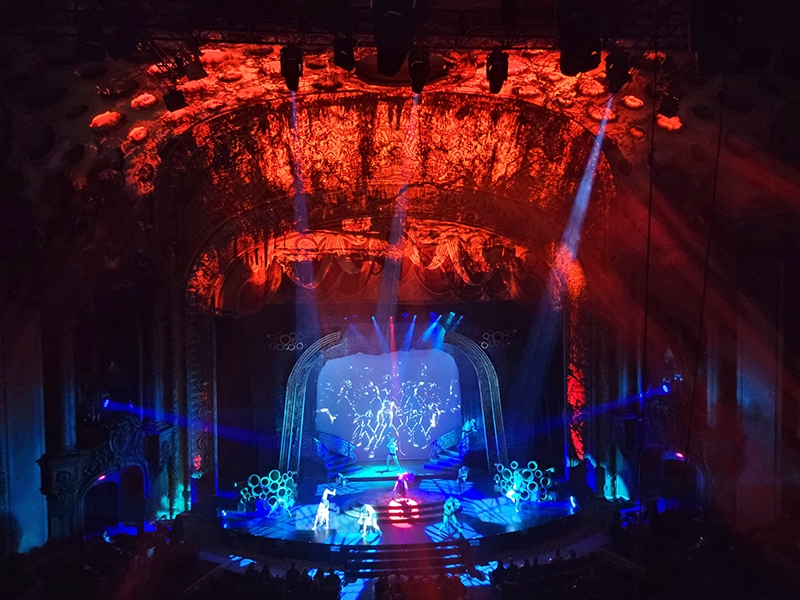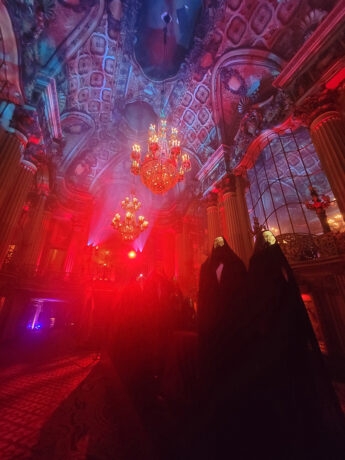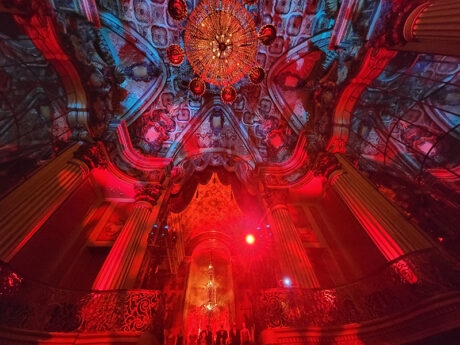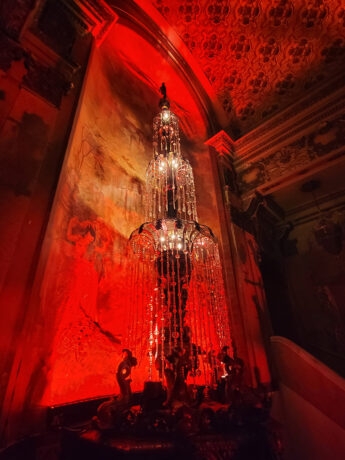About Us
4Wall In The News
Angel of Light at the Historic Los Angeles Theater

4Wall's Virtual Production team provided audio, lighting, video tile, projectors, and Disguise servers to this immersive experience. They worked with content creators to create a workflow unique to the space and experience.
The article below was originally posted on PLSN's website here.
Old Hollywood came alive this past fall with the immersive walk-through horror experience, Angel of Light at the historic Los Angeles Theatre in downtown Los Angeles. Backed by immersive experience and technology company, Odeon in collaboration with Fever, this original storyline was co-created by Chris Anastas and Mark Binder, and produced by Buck Mason, COO of IMN Creative. The walk-through audience was transported to Hollywood of 1935 to witness the story of singer Rota Krisha, a story that included a dash of ancient curses, secrets, and demonic possession. From the technical side, this immersive experience was headed up the Special Projects Division of 4Wall Entertainment, led by Ben Danielowski and Mathew Leland, co-project managers and handling the systems design. Danielowski dealt with much of the specialized audio requirements and Leland handled the projection mapping system. 4Wall provided the lighting, video, and audio equipment, as well as an array of technical solutions for this haunting immersive experience. The lighting throughout the ornate Los Angeles Theatre was designed by Jared A. Sayeg.
When co-Creator Binder is asked for a description of Angel of Light, he succinctly sums it up as, "It's like falling into a Salvador Dali or Yves Tanguy painting and doing absinthe with Fellini. It was kind of a unique blend of a traditional haunted house like you would expect from a theme park, but in combination with a live theatrical element-a stage show with elements of actor interaction. Mix all that up with the latest tech and visual effects, a Dolby Atmos sound system, projection mapping, and motion capture; sort of everything that we do in feature films. It was a mix of all of that. I call this new field of expression-Live Based Entertainment (LBE); it's where we're going right now. Our specialty has been long arc narrative-you sit in a dark room, preferably, and you get entertained, told the story, and taken on a linear journey. We're trying to find new ways of entertaining and telling stories."
The Angel of Light was a walk-through experience, so the attendees got to explore many areas of the theater, which required LD Sayeg to light almost all the spaces of the building in addition to the action that took place on stage for the finale of the experience. "For Jared specifically, there was so much texture and scenic elements native to the theater to use and dimension that took the design that much further," explains Mason. "We had the opportunity to use the whole theater. It was backstage, in the depths of the theater. It was up on the mezzanine, multiple different scenes telling this story, and lots and lots of opportunity to take it to the next level. The fact that we were building the story within the canvas that we had as opposed to having to do everything from scratch. I think we were very focused on creating a story and telling a story within the arena that we had. That's what I think made it very personal and unique."

Atmospheric Lighting
The historic Los Angeles Theatre on Broadway in downtown Los Angeles opened in 1931 with the theater's interior design based on French Baroque, with a grand central staircase and gold brocade drapes. It has, for many years, been considered to be among the city's most lavish theatrical landmarks. It fully lives up to the description of atmospheric theater and has been well-preserved, making it a great choice to host Angel of Light. LD Sayeg had lit award shows in the space, so was familiar with it. "Starting with the choice of venue, it's easily the most opulent and the largest of the theaters on Broadway," says the designer. "So that alone was really thrilling. I was familiar with the venue, and I've toured it, but when this project came to me and the whole approach of an immersive, haunted theater experience, that was really exciting. We got to break a lot of boundaries and do things we normally don't get to do. The theater itself, the architecture, really lends itself to this type of environment and that worked in everyone's favor. We lit every part of the building. The experience for the patrons begins right in the lobby. You walk through all the way down into the ballroom, the dressing rooms backstage; into the mezzanine, balconies, corridors, offices, and even outside and all the way back into the building again as well as to auxiliary rooms that we've repurposed on the intermediate level. Then you end the experience in the main auditorium with a stage production. Each room was its own experience and had a different feel, but overall, the goal was to create an ominous, threatening, and dark environment and ending with a bit of spectacle with the live stage show."
The Los Angeles is no longer a working theater in the traditional sense. These days, it's rented out for events or movie or music video shoots. Many of the lighting positions needed to be created to work for the specific needs of Angel of Light. "Probably the biggest thing, early on, was laying out our lighting positions, ensuring that we did not have positions that blocked the projection [mapping in the auditorium]," explains Sayeg. "That dictated a lot of our front of house positions, in that we didn't have trusses where we normally would. There's a very deep apron in front of house where much of the performance took place. So, we had to build custom positions in order to light all the way downstage, but also to clear the architecture of the theater so that projection would have a clear shot. My first experience here was designing the 2012 Ovation Awards and it was great having that experience previously, being able to apply it on this much larger scale."
Outside of the auditorium and onstage, there were a lot of non-traditional spaces like offices and hallways to light, both for the atmosphere of the experience as well as the safety of the audience. Sayeg points out that "nothing was battery powered. Everything was through our control system so it was very much designed as though a theme park lighting rig would be. Everything was fully automated, and could be triggered at a certain time, for system checks by the crew before we opened to the public, and then there would be shutdown procedures. The trickier locations, like the hallways and offices, were indeed a challenge, but we found small fixtures that really were a perfect fit for the application. 4Wall supplied the package and was a great resource."
A big part of the lighting for this project was not just the theatrical equipment that was brought in, but Sayeg's lighting team did a full survey of the architectural lighting of the building. "That lighting, was of course, all incandescent and original fixtures from 1931. My team and I did an in-depth survey of every fixture, what type it was, how many sockets, the circuiting layout, what breakers it goes to. All the lamps in the conventional fixtures and architectural fixtures were changed out. So, we used flicker bulbs, we used [Astera] NYX LED bulbs. That was the first pass at changing the overall look of the building to get it more ominous and to have a lot more control over what we'd be seeing."
Key Equipment Choices
For the finale piece on the stage, Sayeg chose to go with some standard automated lights for his design. "The workhorse for the main stage show was the Elation Artiste Picaso, which is a fantastic fixture. Then globally, throughout the whole property, we used a lot of CHAUVET's COLORdash Accent 3s, which are really small. They weren't very intrusive and offered enough output and a great color range. We loved those fixtures. We did have a mix of sources; there was some incandescent, but mostly we were LED and largely automated throughout the whole property because power was something we needed to be aware of the amount of all gear and what the other departments were running as well as the HVAC system. For control, we used the ETC Eos system. We had a programming wing so we could move around during programming and focus calls. Then the show was operated from an ETC Gio @5 and Ion Xe."
Sayeg has worked on a number of projects with 4Wall Entertainment and had a good experience with them for Angel of Light. "I've worked with them on the NBA and on other projects; the gear was great," says Sayeg. "Will Jennings was our Project Manager and was absolutely wonderful in coordinating the many aspects and details of this project. I have to say that the best thing about this was really the collaboration with my team, so I'd call out my Associate Megan Hong, my Lighting Programmer David Patrick, and Assistant Designer Winston Limauge, who also drafted everything. They all were amazing contributors to making this happen. It was a big scale project that came together very quickly. It took a lot of coordination and a lot of very rapid prep work from my team and from the shop."
Quite a few colleagues of Sayeg came to see Angel of Light. Everyone reacted positively to seeing the architecture of the building in a new light, he notes, "As opposed to generally always being in work light conditions, it was great to really dramatize the architecture and enhance the shadows; make things bigger and bolder, or recess into darkness. I think that was exciting because the building itself is so extravagantly opulent. It's seeing the Haunted Mansion on a grander scale. That was really the takeaway for everyone. To have had the opportunity to light this wonderful venue in such a dramatic way was really exciting."

Projection Mapping
The projection mapping portion of the experience was located in the main auditorium and focused onto the very detailed baroque architecture of the space. Sayeg speaks about layering his lighting with the projection mapping of the space. "Here the lighting really drove the color palette and the musical hits with the projection. The stage production is very heavily dance focused and all the projection imagery enhanced the architecture, specifically the ceiling of the theater."
4Wall's Mathew Leland handled the projection mapping system, bringing 4Wall's experience to bear on the project. "I think this was Mark and Buck's first foray into this type of experience, so part of the partnership with them was really trying to bring all the high level tools that we could to help coordinate with their folks, who were used to doing post effects for cinema and TV," comments Leland. "Really talented people, but they maybe hadn't necessarily worked in this aspect. We decided to lean into the disguise workflows that we know well. In June, we scanned the theater and gave them a first round mesh of the entire theater. We let them play with that until they really figured out where they wanted their palette to be. Then they were able to really go nuts on the content without any help from us because they had a great representation of what the theater was going to be. We were able to go in with disguise and their OmniCal camera-based calibration system and do a detailed mapping; it transferred quite well."
For Angel of Light's projection mapping portion, there were three full scrims that were being mapped; as well as the arch of the proscenium, and a large portion of the ornate ceiling. "There were also two gargoyle-like faces," says Leland, "that were built into the architecture of the theater itself that were mapped as well. For the projectors, it was a mix with some Christie Boxers, but for the most part we were using Epson 25K projectors, all located in the mezzanine, which had all the seats removed."
Content Creation
For the projection mapping content, Binder, Mason, and the creative team shot the footage and created the visual assets in house. "The thing that fascinates me about projection mapping in general is it gives it a sense of life to inanimate objects," comments Binder. They were able to blend Sayeg's lighting with the projection. "These shades, the tonality that we've created with traditional lighting look so amazing," says Binder, but then making sure that the shadows would hide and keep darkness around the theater with projection mapping. The projection mapping in the main theater is where we have the reveal of the Angel of Light, a digital motion capture-created character, which was an asset we created. The Angel of Light appeared on the stage and the proscenium, because we had a huge dance performance piece that happened within all this. Projecting onto the scrims, on the theater itself, and all the beautiful elements of the theater that we were able to map onto made the whole dynamic work so well."
Producer Mason, who has known and worked with Sayeg a lot over the years, was very pleased with the results of the designer's lighting. "Jared, and the entire creative team, were able to light live talent downstage, and work effectively with the projection mapping, upstage," says Mason. "We have this motion capture Angel of Light that performed with the dancers, so you couldn't blow that out with lighting. It had to stand out. Everybody did a very effective job at lighting everything that happened on stage while still being able to accentuate that digital creature that everybody needed to see to tell the story."

A Trip Into the Mindscape Cage
As part of the Angel of Light immersive experience, there was a room dubbed, the 'Mindscape Cage', comprised of blow-through LED panels that were fed content from the disguise media server. It was triggered by the Entertainment Sciences Group's VenueMagic® system that was used to control the whole walk-through experience. "The Mindscape Cage, as we called it, was a journey into a room that projected a story of this person, walking into their mind and what that would be in a visual and sonic landscape," explains Binder. "One of the things that we were very eager to explore was a perforated LED panel that was a combination of non-compromising abilities to parlay a story in a confined space but that there were no compromises on the visuals and sound." Leland and Danielowski from 4Wall brought in ROE Visual V8T transparent LED video panels to solve this audio challenge for Binder.
For the content for the Mindscape Cage, Binder and Mason shot a lot of footage that they then manipulated for the show. "We went to Eastern Europe and did a bunch of shooting, then brought it back and did a lot of manipulation in VFX," explains Binder. "We paired it with our Dolby 9.1.6. Theatre Atmos array for audio and implemented it all into this room, conjuring up a three-dimensional portal of an interpretation of someone's possessed mind. It was very effective."

Solutions to Challenges
When asked about solutions that 4Wall brought to the challenges of the project, Leland comments, "We were happy to be able to bring projection mapping to high level content creators who maybe just haven't worked in that medium before," he says. "They were able to do a really great job of nesting themselves into the new workflow. Obviously, they were great compositors already, but working within a mesh space, which was new for them. The other challenge we dealt with, I would say, was getting the system up and running in an old theater. Just the basics; getting power in there and finding locations without expecting to do any building. The theater is almost 100 years old, so we really tried to work around the natural structure that already existed; to find projection placements. It's always a balance to mix what is ideal and what we have and then try to find a blend between the two so that we can get great shots for the audience."
In terms of overall control, the team went with three separate systems that were then tied together to synchronize all the production elements. Danielowski explains, "There were a couple of control systems for the entirety of the haunt, but we approached the main theater as a singular system that could be triggered from the greater VenueMagic® system that they were using to run the whole experience. disguise ultimately ran the video; the lighting console ran the lighting; and Mark's Dolby Atmos system ran the audio portion, then it was all synchronized using timecode."
Binder and Mason were thrilled with the results and give a lot of credit to 4Wall for their support for Angel of Light. Mason states that, "4Wall was instrumental in being able to pull this off in terms of technology and knowledge. We couldn't have done it without them. They were amazing partners; Mat and Ben are both amazing designers and technicians in their own right and their support was pivotal. This would not have happened without them."
"We certainly have the array of gear to cover all the audio, video, and lighting needs of this scale project," sums up Danielowski. "However, outside of having the quantity of gear, we have a group of people on our Special Projects team who really understand immersive experiences; it's really what we love to do. This was a neat project to work on; especially as it was in a theater that's already haunted. To do a haunting inside a haunted theater, it was pretty rad!"
